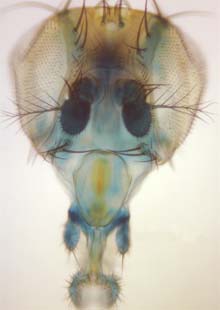A team of researchers that includes biologists from Washington University in St. Louis has discovered that a gene involved in the development and function of the fruit fly antenna also gives the organism its color vision.

Claude Desplan, Ph.D., professor of biology at New York University, and his students made the discovery and provided the data. Ian Duncan, Washington University professor of biology, and his wife, research assistant Dianne Duncan, provided the Desplan laboratory fruit fly (Drosophila) clones and mutants and technical assistance that helped locate where the gene, called spineless, is expressed in the retina.
The Duncans have a long history with the spineless gene. Their interest has been in the role spineless plays in directing development of the antenna, Drosophila‘s primary olfactory organ. Years ago, they deleted the spineless gene and found that the mutants then produced a leg instead of an antenna.
“Spineless plays a key role in the antenna and maxillary palp, the two major olfactory organs of the fly,” said Ian Duncan. “It’s also important in mechanosensory bristles and in the taste receptors of the legs, wings, and mouth parts. There has been a sensory theme to the gene, and now we learn from Claude’s work that it plays a key role in color vision.”
In humans the closest known homolog (counterpart) is the arylhydrocarbon (‘dioxin’) receptor, a key protein in human health that senses a wide variety of synthetic compounds and then activates expression of detoxification genes. The dioxin receptor is studied closely in cancer biology and toxicology.
Recently, the Duncans had found a relationship between spineless and a gene called homothorax. Desplan’s group had shown that homothorax plays an important role in the Drosophila eye, and after hearing Ian Duncan make a presentation on the homothorax-spineless relationship in the antenna, the Desplan laboratory decided to study spineless in the eye.
The collaborators published their results in the March 9, 2006 issue of Nature.
Random pattern
The Drosophila retina is comprised of clusters of photosensitive cells called ommatidia. Two types of ommatidia are present: one is sensitive to long-wave light and the other to short-wave light. This difference is due to the expression of different light-sensitive pigments (rhodopsins) in the two central photoreceptor cells (R7 and R8) of each ommatidial cluster. Spineless determines the long-wave type by activating expression of rhodopsin-4 in R7 cells. In ommatidia where spineless is not expressed, R7 expresses the short-wave sensitive rhodopsin-3.
“The fascinating thing in this work is that the longer wave length sensitive ommatidia are randomly positioned,” said Duncan. “About 70 percent of the ommatidia sense longer wavelength and 30 percent sense short-wave length. It’s been a mystery how you generate a random pattern like that and still have that ratio.”
Using the tools that the Duncan laboratory provided, Desplan’s group mapped the regulatory region in the spineless gene that drives the random pattern mechanism.
“Nobody knew what controlled this random pattern,” said Dianne Duncan. “Now we know it’s spineless. We’ve known for a while that spineless has several sensory functions and we thought it might be a bit underrated in developmental biology. Now we add color vision to its duties.”

Spineless also appears to control communication between the R7 and R8 photoreceptors. “It has been known for some time that the expression of rhodopsin genes in R7 and R8 is coupled with the particular genes expressed in R8 being determined by the adjacent R7 cells,” said Ian Duncan.
“An additional important finding in the paper is that spineless controls this signaling between R7 and R8.”
Link to human odor perception
The Duncans will continue to look for other genes that spineless controls in making an antenna. They have shown that spineless acts together with two other factors, Homothorax and Distalless, and identified downstream target genes by virtue of their having clustered binding sites for these factors. And they are looking into similarities between spineless and the mammalian dioxin receptor. In a collaboration with a University of Wisconsin researcher, they have put the mammalian dioxin receptor gene into Drosophila, where, surprisingly, it specifies the making of an antenna.
“When you think about it, the antenna is quite special,” Dianne Duncan said. “It contains many proteins not expressed anywhere else in the fly. These include many odor receptor proteins that are expressed in subsets of cells within the antenna. Our hope is that by unraveling how development of the Drosophila antenna is controlled, we will gain important insights into how human odor perception works.”